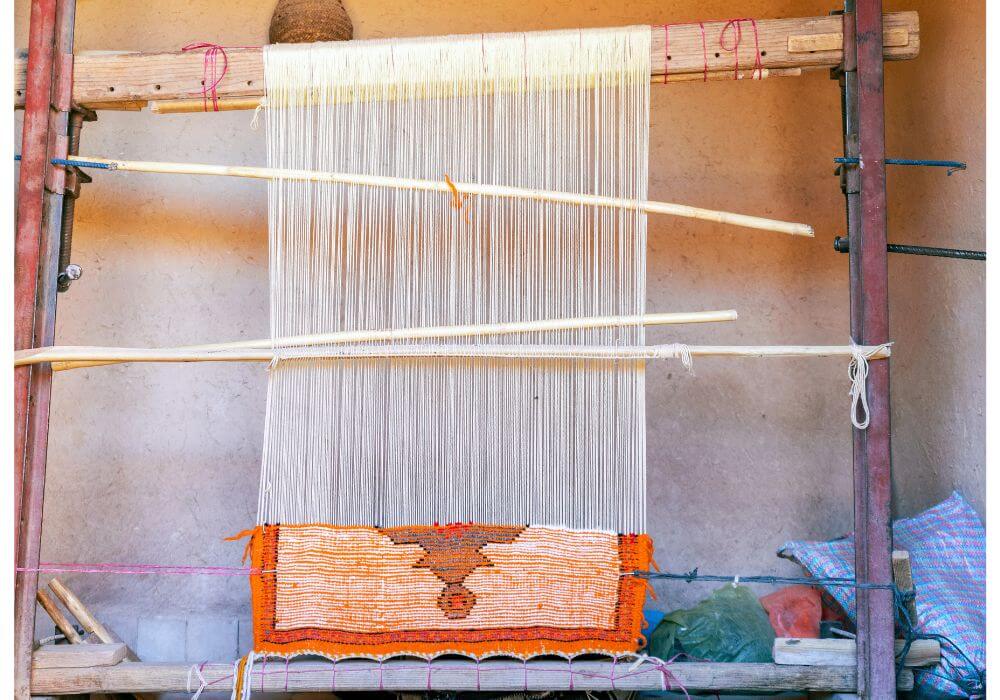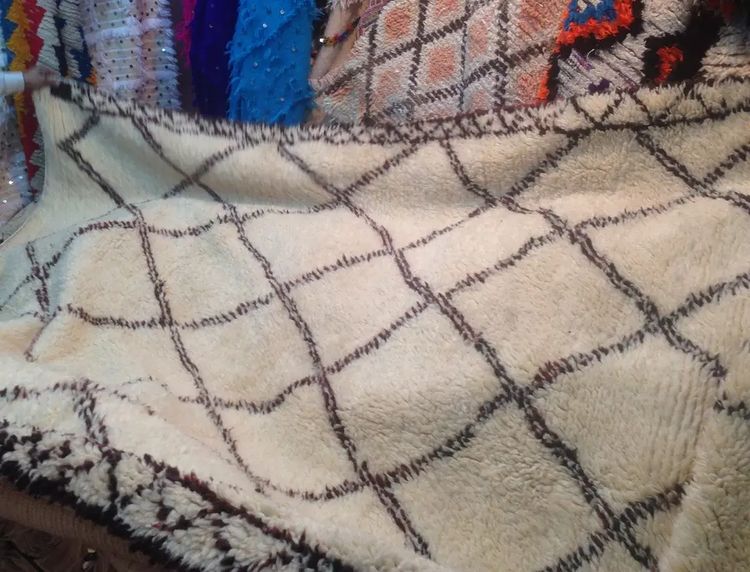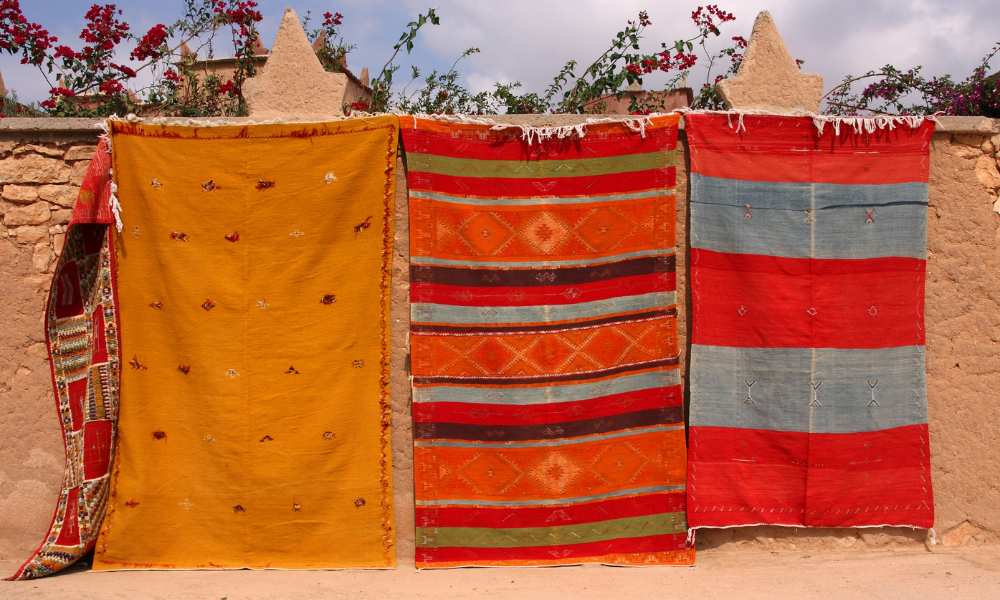Finding an authentic handmade Moroccan rug can be quite the challenge.
With so many ‘dupes’ out there, synthetic rugs made to look vintage or to pass as original Berber rugs, for example, it’s hard to get your hands on a genuine traditional rug.
In this guide, we discuss the history behind the Moroccan rug, the different designs, and types by region, where you can go about buying a rug in Marrakech, as well as how to take proper care of your traditional Moroccan carpet.
Some links below may be affiliate links. As an Amazon Associate I earn from qualifying purchases.
Table of Contents
The history behind the Moroccan rug
The history of traditional Moroccan rugs dates as far back as the Paleolithic era. What is now considered to be an artisanal craft first rose to prominence due to necessity.
Moroccan carpets were woven by Berber tribes all across the kingdom for their utility to adjust to the changing climatic conditions of the land.
Because these tribes were primarily nomadic, they would travel from the Atlas mountains to the Sahara desert and the tropical forests of Morocco.

To cope with the distinctive and varying weather conditions, the Indigenous people of Morocco began to weave rugs, carpets, and tapestry to preserve their homes from the fluctuations in temperature.
The snowcapped elevations of the Atlas mountains gave birth to heavy sleeping mats and bed covers made from thick-pile wool to provide warmth during the harsh winter months.
On the other hand, the unbearable heat of the Sahara desert inspired the creation of lighter shawls and flat-weave carpets.
Soon after these rugs started to gain popularity amongst other tribes, they became a way to display one’s heritage and to pass down different signs, symbols, and stories from one generation to the next.
Each carpet tells a story through the intricate designs, patterns, and motifs.
Some of these rugs can take up to a year to finish because of the exquisite grace and unmatched precision.
Not only that but also in the spontaneous yet allusive geometric designs that illustrate everything from feminine essence and fertility to spirituality and male protection.
Furthermore, the fluid interaction of these symbols and the distinguished way in which they’re flawlessly interlaced allows the weaver to tell her life story from one end to the other.
The various types of Moroccan rugs by region
Beni Ourain Moroccan rug – Middle Atlas

Beni Ourain rugs originally come from the Atlas mountains, a region that is distinguished by its cold climate.
These rugs require a massive amount of soft, dense, and first-muted wool.
Because wealthy Berber families can afford the quantities of wool needed to weave these carpets, they usually keep the primary color, being cloud white or light sandy cream.
Each rug is then adorned with delicate black or light brown geometric patterns and lines. These are often asymmetrical or mismatched, which further adds to the rug’s charm and uniqueness.
The light tones and simplistic approach to design make the Beni Ourain rug the perfect addition to any minimalist home.
Beni Mguild Moroccan rug – Middle Atlas
Because Moroccan rugs vary in thickness depending on the climate and weather conditions, this is reflected in the thick and plush Beni Mguild weaves that originate in the harsh Western Middle Atlas region.
These rugs are often crafted on a vertical loom and use deep shades of brown, red, purple, and blue.
The heavy-pile can be flipped to the other side, which is much flatter, to better adapt to the seasonal changes in the warmer months.
Azilal Moroccan rug – High Atlas
The Azilal rugs are characterized by their bold patterns, vibrant colors, and elaborate detailing. These highly sought-after pieces of art are usually single-knotted and woven using wool to depict a variety of motifs and symbolism.
The recurring themes are all inspired by tribal life including marking events such as birth, maternity, weddings, and even farming. Azilal rugs are the perfect marriage between the colorful Boucherouite and the first mowing wool of Beni Ourain.
Boucherouite Moroccan rug – All tribes
The name Boucherouite literally translates as someone using scraps of fabric or discarded clothing.
This rug emerged from lower-income families and households that couldn’t afford to buy wool, so they used old tunics and any unused materials of clothing to recycle as carpets.
These rag rugs are one of the most fun, colorful, and visually captivating carpets. They were often used when women needed to sit down and prepare food or to simply hang out and tell stories.
Because they’re cheaper to make compared to other rugs, they have an incredibly tactile quality due to the variety in texture and composition.
Kilim Moroccan rug – All tribes

Moroccan Kilim or Hanbel rugs get their name from the Persian “Gelim” which stands for a carpet without a velvet-like pile. These rugs are flat and embroidered instead of being knotted.
Because they vary from one tribe to the next, the details, patterns, and motifs also differ to depict the identity of the tribes weaving them.
Although they are less colorful, they’re more embellished featuring more refined decorations. Moreover, they can often be found adorning the tents of the Berber tribes in the Sahara desert region.
They’re very thin and lightweight which also makes them easier to transport, hence highly convenient for the nomadic existence.
Revival rugs
Due to their charm and delicate beauty, these traditional Moroccan rugs have managed to gain tremendous popularity all over the world.
They were first heralded in the West by mid-century modern architects such as Le Corbusier, Alvar Alto, Charles, and Ray Eames.
In fact, American Architect Frank Llyod Wright was known to travel to Morocco and collect rugs to bring back to his clients.
Because of the versatility in options, Moroccan rugs can be used to complement any design scheme or decor aesthetic.
They also allow you to bring that perfect touch of character and style balance to instantly transform any home interior from bland to visually captivating.
How to pick the perfect Moroccan rug authentic and handmade
You can acquire one of these art pieces from the comfort of your own home, without having to spend an entire day perusing the old Medinas and Souks or dodging shady salesmen.
Vintage Moroccan Carpet, La Handira, and Les Nomades de Marrakech, all offer large selections of every type, style, and design of Moroccan rugs you can think of.
From the minimalistic Ben Ourain rugs to the bold and colorful Azilal carpets, you’re bound to find the perfect Moroccan rug to embellish your living space.
Where to buy the original Moroccan rug in Marrakech
Vintage Moroccan Carpet, La Handira, and Les Nomades de Marrakech all have stores in the Marrakech Medina, so if you want the tactile experience of feeling the rugs, looking at all the beautiful designs, and seeing the vibrant colors in person, you can visit their shops on your trip to Marrakech.
The authenticity of the rugs will be of no issue with the added benefit of getting a more accurate sense of the style and size of the carpets.
They also offer pieces that fall under whatever budget you’re working with.
You can get a delightful and original Moroccan rug as low as $350 but you can also find gorgeous vintage ones for a higher price range.
Discover Moroccan Carpets on Amazon!
How to care for your rug
If you’re dealing with a stain or spilled food and drink, start by applying paper towels to dry that spot. Then put some baking soda as soon as you can to help soak up the liquid from the rug.
If the stain is gone then you can vacuum that spot, if not, use a vinegar and baking soda solution or a distiller vinegar mixture (1:1 ratio of distilled water and vinegar) to get rid of those stubborn stains.
Keep in mind that the wool needs to be saturated for 10 minutes before you let it dry completely. On the other hand, the deep cleaning process depends on how colorful your rug is.
If you’re concerned that colors might bleed into one another, then definitely opt for spot cleaning (it’s going to be long and tedious, but your rug will remain intact).
If the rug is less colorful, a Beni Ourain for instance, hang it up or drape it over a ladder and use a power washer if you have one.
Allow it time to soak and get all the dirt out (using a soft bristle brush) before you let it air dry
Conclusion.
Moroccan rugs are not just floor coverings; they are intricate pieces of art with a rich history and cultural significance.
From the utilitarian designs born out of necessity to the vibrant and symbolic patterns that tell stories, these rugs have captivated the world’s attention.
Whether you’re drawn to the minimalist elegance of Beni Ourain rugs or the bold colors of Azilal carpets, there’s a Moroccan rug for every taste and style.
You can find these treasures both online and in the bustling markets of Marrakech.

